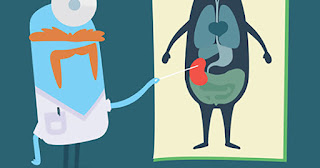Q: Why kidney is expensive?
A: According to organization of American Kidney Fund, nearly 100,000 people are on the waiting list for a kidney transplant. Many more people are waiting for a kidney than for all other organs combined. Unfortunately, the number of people waiting for kidneys is much larger than the number of available kidneys from living and deceased donors. So, just like economy balance, if the demand is larger than supply, the cost of product will increase. Thats why the kidney cost is expensive.
Q: Why does our urine bleeding if our kidney damage?
A: Kidney function in filtering blood from waste product. These blood enter to kidney through artery, we called it by renal artery. If our kidney damage, the blood will not be well filtered and thus we find the blood in our urine.
Q : What causes kidney stone?
A: Firstly, we have to know what the kidney stone is. Kidney stones or renal calculi is condition of urine that contains more crystal of calcium, oxalate and uric acid than the fluid. There are many factors causes kidney stone. 1) Dietary factors, high doses of vitamin D, intestinal bypass surgery and several metabolic disorders can increase the concentration of calcium or oxalate in urine. 2) infection in urinary tract, 3) lose too much fluid because of chronic diarrhea or malabsorption.
Q: How did the kidney work if there is just 1 kidney, did they work as same as the kidney was complete?
A: Yes it is. One kidney can filter enough blood to keep our body functioning normally. This is why we can survive and be healthy with only one kidney. But there is also risk. If we have two kidneys, we will be safetier than have only one. Because if someday, one of our kidney is damage, we still have another to compensate.
Q: What is the function of renal pyramid?
A: Renal pyramid contain nephrons which are function in filtration process.
Q: what are the diseases that can attack the renal pelvis?
A: It is Pyelonephritis. Pyelonephritis is infection and inflammation of the kidney tissue and the renal pelvis (the cavity formed by the expansion of the upper end of the ureter, the tube that conveys urine to the bladder). The infection is usually bacterial.































